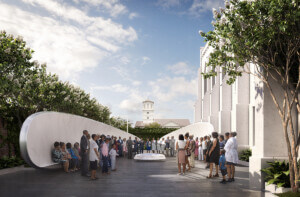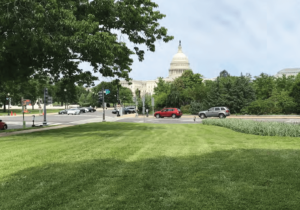Years ago, Frank Gehry asked sculptor Sabin Howard to help him design a memorial to Dwight D. Eisenhower in Washington, D.C. Though the job didn’t pan out for “stylistic reasons,” Howard said, it planted the seed that grew his interest in creating commemorative spaces.
“I proved to have too much of an opinion,” Howard told AN. “I said to Frank, ‘Look, do you want me to be your in-house sculptor or you want me to tell you what I really think?’ He goes, ‘Shoot,” and I said, “Well it looks like you designed the Natural History Museum here.”
Had he taken the job, Howard would have been engulfed in what’s turned out to be a two-decade-long controversial battle to get the memorial built ahead of the 2020 Victory in Europe Day. While he didn’t end up on this monumental project in the nation’s capital, he did venture into the complexities of another.
This spring, the U.S. Commission of Fine Arts (CFA) approved Howard’s sculptural contribution to the upcoming National WWI Memorial in Pershing Park, a 1.76-acre landscape set along Pennsylvania Avenue in D.C. Designed by Joseph Weishaar, “The Weight of Sacrifice” is the result of another two-decade controversial effort to pay tribute to an often overlooked period of history. A Soldier’s Journey, Howard’s massive, 60-foot-long, 10-foot-high bronze figure sculpture, will be the centerpiece of the renovated landscape, and a major component of the project that took years for preservationists and the U.S. government to sign off on.
“As an entire team, we struggled with the urban context at the beginning,” said Weishaar, who was selected for the project just a few years after graduating from the University of Arkansas’s Fay Jones School of Architecture and Design in 2013. “Where do you draw the boundaries between urban park and memorial?”
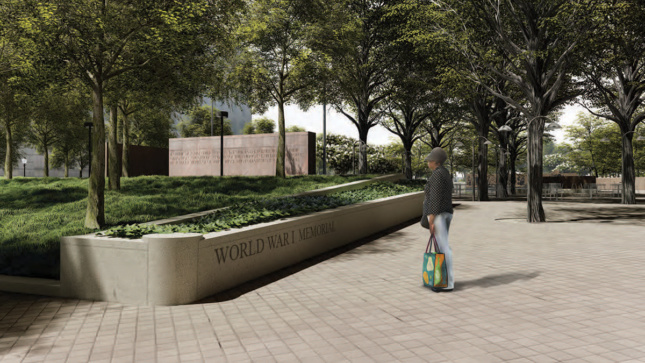
This was one of the biggest questions that needed to be answered. Unlike most major war memorials in Washington, D.C., this one is not located on the National Mall, though in late 2017 it was hoping to be moved there. It’s slated for Pershing Park, steps away from the White House. Opened in May 1981, the park was an instant success, featuring a design by award-winning landscape architect M. Paul Friedberg. Among its most distinctive features is a monumental fountain that flows into a pond that becomes an ice rink every winter, protected by subtle grade changes from the surrounding hustle and bustle. In recent years, the revered landscape had begun suffering from neglect and underuse.
The new plan to restore 95 percent of the protected urban park has been met with major contention, despite the efforts of Weishaar and The U.S. World War One Centennial Commission, the group created in 2012 to fundraise and lobby for the project, to respect the site’s historic legacy and help it stand out.
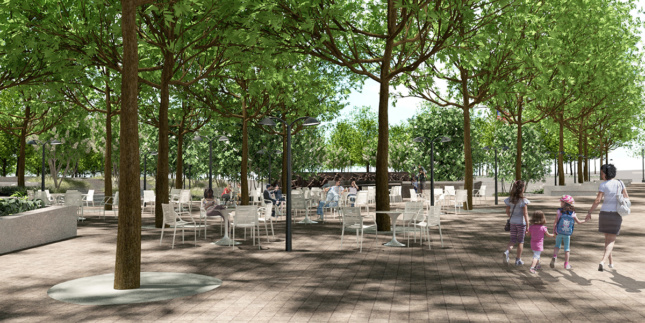
“We want to recapture some of the energy the park had when it was first completed and then overlay this new design element of the memorial so that it won’t take away from the landscape,” Weishaar said. “If you make memorials too big and too oppressive, then that’s all anybody can focus on. They won’t sit there and eat their lunch. They’ll always feel like they have to be reverent.”
Everything visible in current renderings of the memorial is the result of several redesigns, all to make the architectural intervention smaller and smaller. Since Weishaar’s design was selected out of 360 entries in January 2016, he’s reworked the scheme to appease preservation groups as well as the CFA, National Capital Planning Commission, and the National Park Service. Though the largest addition to Pershing Park will be the memorial sculpture itself, not everyone is satisfied with the final look.
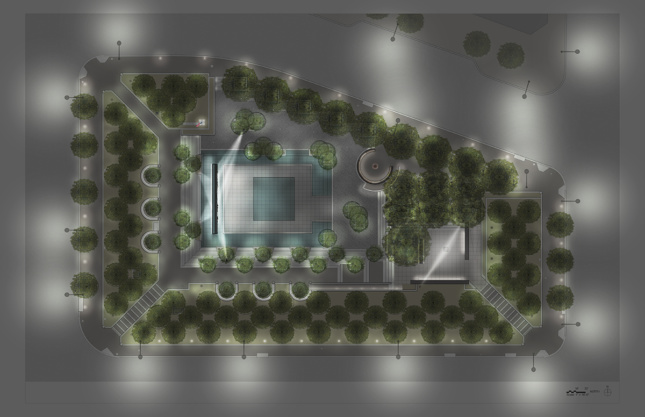
Charles Birnbaum, president and CEO of The Cultural Landscape Foundation (TCLF), has both testified before the CFA and submitted a letter to NPS about his concerns.
“I’m about as glass-half-full on this as I could probably be, but I’m proud of the public process that TCLF participated in,” he told AN. “At the end of the day, it’s unfortunate that the central water feature will not remain and I still believe that having a wall of this length and height will significantly alter the visual and spatial relationship between the upper and lower plazas.”
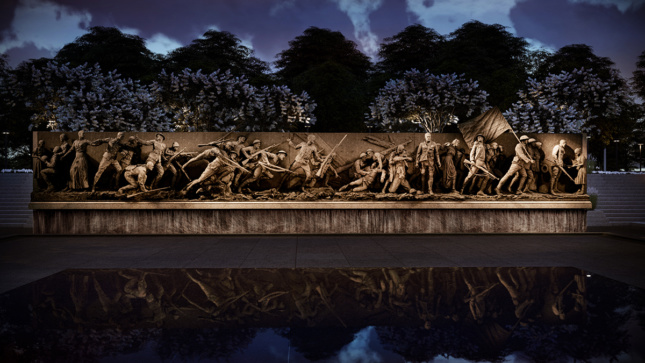
Weishaar’s plan integrates water as a focal point but has significantly reduced the size of the park’s existing water feature to allow people to walk up close to the relief sculpture—a moment on the site that Howard was keen on highlighting. The story unfolds before the viewer’s eyes—a person of average height will see the knees of the figures straight on. “I want people to have a visceral reaction to this,” Howard said. “It reads like a film.”
Though the sculpture seems traditional, Howard utilized a contemporary process called photogrammetry to create it. He took images with his cell phone of actors portraying scenes from wartime and then combined the individual shots to find the pattern that would create the best flow for the visual story. It took him 12 versions, done over nine months, to determine the final relief. From there, he spent 700 hours over two months drawing a detailed mock-up of the piece.
“For this part, I wasn’t even sculpting,” Howard said. “I was creating a hierarchical construction, a system of design that we could break down to do the sculpture quickly.”
This kind of commission, he said, is something that would have taken him 15 years to complete, but he’s been charged with doing it in four. He begins sculpting in August now that nearly all approvals have gone through, and he’ll be working with the Pangolin Editions sculpture foundry in England to assemble the figure molds.
“I’m trying to be as disruptive as possible,” Howard said. “I never thought my career would take this kind of turn into using tech to create classical figurative art, but I don’t think I can go back now.”

As for the potential collaboration with Gehry, Howard’s not sure where that journey would have taken him. In working with Weishaar, however, he’s impressed himself with the lengths at which he and the design team have been willing to go to make this memorial happen.
“To me, art is not democratic,” he said. “But the park is. I was very stubborn with the sculpture design, but Joseph had to be very flexible with the landscape.”
When Weishaar submitted his design for the commission, he was just 25 years old, about the average age of a soldier who fought in the war. While making his proposal, he learned more about the history of WWI than he ever did in grade school, he said. It’s become his mission—and his job—to spread the word.
“Not only are we turning this park into a memorial, we’re also putting both the landscape and the war back on the map and on the minds of people.”
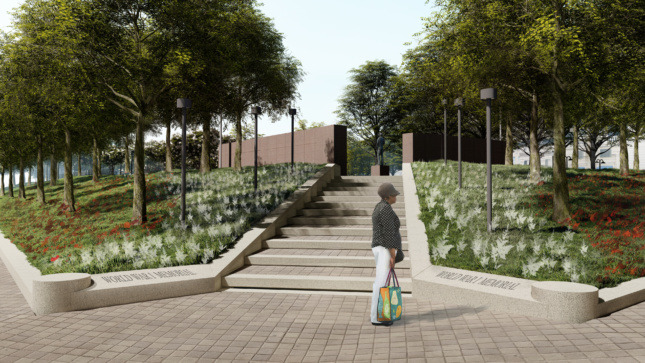
Originally, the National WWI Memorial was supposed to be completed by November 2018 ahead of the war’s centennial. Now, the project is estimated to be done in late 2021, pending fundraising. The design team will meet with the CFA again this summer to further discuss the site plan.








